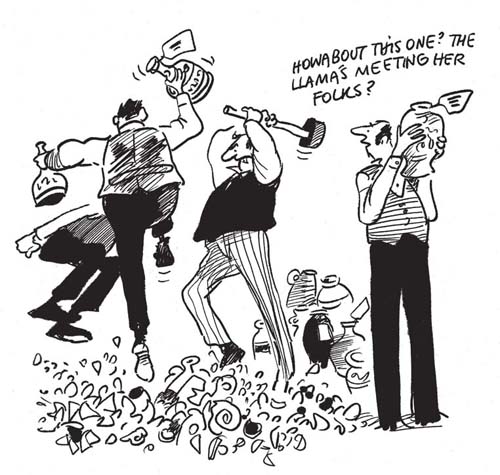
According to Herodotus, the Greek historian of the fifth century BC, the women of ancient Egypt were all unfaithful. When a son of Ramesses II had been blind for 10 years, an oracle from the city of Buto declared to him that the time of his punishment was drawing to an end, and that he should regain his sight by washing his eyes with the menses of a woman who had never had intercourse with any man but her own husband. Pheros made a trial with his own wife first, but still remained blind, even though he tried with all women, one after the other. When he finally recovered his sight, he took all the women whom he had tried, gathered them in one town, and burnt them and the town — but he married the woman by whose means he had recovered sight.
In a Mesopotamian Cuneiform wedding contract testimony, arguing about the return of the house as part of the dowry, Iddin-aba backs out, saying ‘Your daughter I shall not marry. Tie her up and throw her in the river’ (a reference to the river trial of truth-telling).
An Egyptian papyrus in the British Museum, ‘The Instruction of Ankhsheshonq’, contains rules written by a priest for his youngest son — including the following:
He who sends spittle up to the sky will have it fall on him;
Let your wife see your wealth — do not trust her with it;
Do not open your heart to your wife — what you have said to her goes to the street;
Instructing a woman is like having a sack of sand whose side is split open;
When a man smells of myrrh, his wife is a cat before him;
Do not laugh at a cat.
Hesiod, a Greek poet of the eighth century BC, was very anti-women, seeing them as a necessity but an economic liability with vices: ‘Do not let a woman with a sexy rump deceive you with wheedling and coaxing words; she is after your barn. The man who trusts a woman trusts deceivers.’
Semonides, a poet-philosopher of the seventh century BC, compared women to different creatures: (20)
From the beginning the god made the mind of woman
A thing apart. One he made from the long-haired sow;
While she wallows in the mud and rolls about on the ground,
Everything at home lies in a mess.
Another doesn’t take baths but sits about
In the shit in dirty clothes and gets fatter and fatter .…
The next one was made from a dog, nimble, a bitch like its mother,
And she wants to be in on everything that’s said or done.
Scampering about and nosing into everything,
She yaps it out even if there’s noone to listen.
Her husband can’t stop her with threats,
Not if he flies into a rage and knocks her teeth out with a rock .…
Another woman is from the stumbling and obstinate donkey,
Who only with difficulty and with the use of threats
Is compelled to agree to the perfectly acceptable thing
She had resisted. Otherwise in a corner of the house
She sits munching away all night long, and all day long she sits munching at the hearth
Even so she’ll welcome any male friend
Who comes around with sex on his mind.
Another kind of woman is the wretched, miserable tribe that comes from the weasel.
As far as she is concerned, there is nothing lovely or pleasant
Or delightful or desirable in her.
She’s wild over love-making in bed,
20
But her husband wants to vomit when he comes near her .…
Another one is from the monkey. In this case Zeus has outdone himself
In giving husbands the worst kind of evil.
She has the ugliest face imaginable; and such a woman
Is the laughingstock throughout the town for everyone.
Her body moves awkwardly all the way up to its short neck;
She hardly has an ass and her legs are skinny. What a poor wretch is the husband
Who has to put his arm round such a mess!
There are even traces of prehistoric violence to women. A prehistoric skeleton from South Africa, dating to within the last 2000 years, is that of an adult woman who was shot at close range by two arrows in the back. And the oldest evidence of interhuman violence, recently published, is the skeleton of an adult female from the late Ice Age with an arrowhead in her pelvis — and she was in Sicily! Perhaps a horse’s skull was found with her .…

21